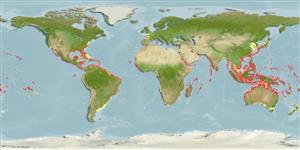Gelidiella acerosa (Forsskål) Feldmann & G. Hamel
Chaffweed| Native range | All suitable habitat | Point map | Year 2050 |

|
| This map was computer-generated and has not yet been reviewed. |
| Gelidiella acerosa AquaMaps Data sources: GBIF OBIS |
Upload your photos
Google image |
No photo available for this species.No drawings available for Gelidiellaceae.
Google image |
No photo available for this species.
Classification / Names Common names | Synonyms | CoL | ITIS | WoRMS
Florideophyceae | Gelidiales | Gelidiellaceae
Environment: milieu / climate zone / depth range / distribution range Ecology
Sessile; depth range 0 - 47 m (Ref. 83908). Tropical
Distribution Countries | FAO areas | Ecosystems | Occurrences | Introductions
Atlantic and Indo-Pacific.
Length at first maturity / Size / Weight / Age
Maturity: Lm ? range ? - ? cm
Short description Morphology
Thalli form wiry mats or clumps attached by rhizoids arising from creeping stolons. Colour yellow-brown to greenish brown when inhabiting tidepools or upper intertidal areas with clear and shallow water, and reddish to purple in shaded upper subtidal and lower intertidal areas. Branches erect, decumbent or prostrate, composed of a terete to compressed central axis and pinnately arranged, filiform lateral branchlets (ramuli) which are upcurved and acuminate, 1 to 6 mm long, and generally decrease in length towards the distal portion of the axes. Few lateral branchlets may develop that give rise to second degree ramuli. In fertile plants, swollen stichidia are formed at the apices of the lateral branchlets. Branches up to 9 cm in length (Ref. 80758).
Utilized for human consumption as food: prepared as salad, dessert gel, or agar jelly, an ingredient in milk products, jams, marmalades, and ice cream; one of the most important raw materials for the manufacture of agar used in pharmaceutical industries, paints, varnishes, electric bulbs, and photographic films; used as culture medium in bacteriology, agar plates in electrophoresis, and other laboratory uses (Ref. 80758). Maximum depth from Ref. 102167. Inhabits shallow waters of the intertidal and upper subtidal zones. Grows in exposed or shaded areas, attached to calcareous substrates such as coralline rocks, rocks covered by crustose algae, and on sandstones or shells of molluscs. Also found in tidepools with relatively high changes in water temperature, pH, salinity and degree of exposure to air are influenced by tide (Ref. 80758).
Life cycle and mating behavior Maturity | Reproduction | Spawning | Eggs | Fecundity | Larvae
Main reference
References | Coordinator | Collaborators
Guiry, M.D. and G.M. Guiry. 2009. (Ref. 80701)
IUCN Red List Status (Ref. 130435)
CITES status (Ref. 108899)
Not Evaluated
CMS (Ref. 116361)
Not Evaluated
Threat to humans
Harmless (Ref. 80758)
Human uses
Fisheries: commercial
| FishSource |
Tools
More information
Internet sources
BHL | BOLD Systems | CISTI | DiscoverLife | FAO(Publication : search) | Fishipedia | GenBank (genome, nucleotide) | GloBI | Gomexsi | Google Books | Google Scholar | Google | PubMed | AlgaeBase | Tree of Life | Wikipedia (Go, Search) | Zoological Record
Estimates based on models
Preferred temperature
(Ref. 115969): 23.2 - 29, mean 27.4 (based on 1648 cells).


